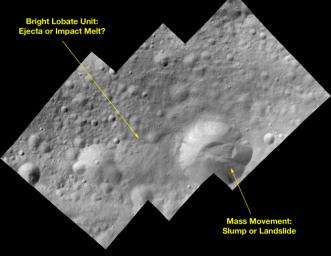
|
Bright-Rayed Crater on Asteroid Vesta
- Click the image above for a larger view
- Full-Res JPEG (1980 x 1530) (272.4 kB)
- Full-Res TIFF (1980 x 1530) (9.1 MB)
Caption:
This image of a bright-rayed crater on giant asteroid Vesta was taken by the framing camera aboard NASA's Dawn spacecraft. The crater is about 2 miles (3.5 kilometers) in diameter and impacted on the rim of an older crater, named Tuccia. The local topography slopes downhill to the southwest. There are about a half dozen bright-rayed craters and several dark-rayed craters visible at the global scale, and more visible at higher resolution. There are also orange ejecta blankets around two large impact craters. These variations suggest compositional variations in either the impactors or in the target rocks at these locations on Vesta, which the science team will be investigating with the visible and infrared mapping spectrometer and the gamma ray and neutron detector instruments over the next year.
Background Info:
The Dawn mission to Vesta and Ceres is managed by NASA's Jet Propulsion Laboratory, a division of the California Institute of Technology in Pasadena, for NASA's Science Mission Directorate, Washington. UCLA is responsible for overall Dawn mission science. The Dawn framing cameras have been developed and built under the leadership of the Max Planck Institute for Solar System Research, Katlenburg-Lindau, Germany, with significant contributions by DLR German Aerospace Center, Institute of Planetary Research, Berlin, and in coordination with the Institute of Computer and Communication Network Engineering, Braunschweig. The Framing Camera project is funded by the Max Planck Society, DLR, and NASA/JPL.
For more information about the Dawn mission, visit: http://www.nasa.gov/dawn and http://www.dawn.jpl.nasa.gov .
Cataloging Keywords:
| Name | Value | Additional Values |
|---|---|---|
| Target | 4 Vesta | |
| System | Main Belt | |
| Target Type | Asteroid | |
| Mission | Dawn | |
| Instrument Host | Dawn | |
| Host Type | Orbiter | |
| Instrument | Framing Camera (FC) | |
| Detector | ||
| Extra Keywords | Color, Crater, Impact, Infrared | |
| Acquisition Date | ||
| Release Date | 2011-12-06 | |
| Date in Caption | ||
| Image Credit | NASA/JPL-Caltech/UCLA/MPS/DLR/IDA | |
| Source | photojournal.jpl.nasa.gov/catalog/PIA15146 | |
| Identifier | PIA15146 | |
